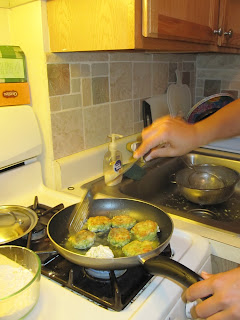Jamie studied for four months in Athens, Greece, where she became well-acquainted with the relaxed, uninhibited, Mediterranean attitude. It was not uncommon in Athens to spend three to four hours each night eating and drinking at one the local tavernas.
Well before her trip abroad Jamie became familiar with Greek cuisine through her mother’s side of the family. She grew up eating dishes like spanakopita, tomato and cucumber salads and stuffed eggplant.
Jamie has always seen cooking and gardening as going hand in hand. She credits her green thumb to her Greek heritage. Greeks like to cook fresh, simple and seasonal and the best way to find fresh ingredients is by picking them from your own back yard. Jamie grew up gardening with her mother, worked at a nursery in high school and for a landscape designer through college. She finds it gratifying to grow her own food and sees it as an artistic pursuit. In Greece it was very common for people to have vegetable patches in their yards and farmer’s markets with fresh produce could be found a few blocks from her house almost every day of the week.
The tavernas in Greece usually didn’t have a set menu, explains Jamie. They cooked from what was available and in season. They usually prepared a dish or two a night and if you didn’t like what they were cooking, you went somewhere else. “Most of the tavernas also make their own house wines, which range anywhere from delicious to unfiltered vinegar,” says Jamie.
Unlike Athens, where the streets are sprinkled with olive and orange trees, Jamie now lives in Colorado, where short summers, cold nights and high altitudes make it more difficult to grow some of the produce she loves. But she has adjusted to growing cooler weather crops and has been whipping up glazed carrot dishes, arugula salads, and French onion soup, with the vegetables from her garden. According to Jamie, meals are tastier and fresher when cooked with homegrown ingredients and she can feel good about eating locally and saving money. Her attitude is: "If you have the space to plant yourself a garden, then you might as well."
Jamie and I enjoyed our meal at Taverna Cretekou this weekend: fresh bread dipped in basil-infused olive oil, saganaki (fried sheep’s milk cheese that they set fire to right at your table), Greek salad, grilled octopus and a roasted leg of lamb with lemon and oregano. And at the end of the night as we sat sipping our complementary wine, we watched a seventy-something-year-old Greek woman climb on top of one of the party tables during “Zorba’s Dance” and start gyrating her hips at a group of young men. We decided to stay for another half hour and watch the spectacle. Jamie shrugged again and said, “Greek people just like to have fun.”
This weekend Jamie was nice enough to cook me some Greek “meze,” the equivalent of tapas in Spain. Her favorite is a dish called kolokithokeftedes (zucchini fritters).
Kolokithokeftedes (zucchini fritters)

Ingredients
3 or 4 zucchinis
1/2 cup of diced yellow onion
1 tablespoon chopped fresh oregano (less if using dried oregano)
2 cloves garlic, minced
1 tsp salt
1/2 tsp black pepper
1 egg
1/2 cup bread crumbs (more if mixture is really wet)
4 tablespoons grated parmesan cheese
1/4 cup crumbled feta
Flour for rolling shaped fritters
Grate the zucchinis on a fine grate setting and place in a strainer. Set strainer over a deep bowl to catch the zucchini juice. Place a heavy bowl on top of the grated zucchinis and use a bottle of wine, soda, juice etc as a weight to help press the juice out of the vegetable. Leave for at least 30 minutes.
Once a good deal of liquid has drained (sometimes up to 16+ oz) mix the grated vegetables with all other ingredients, adding more breadcrumbs if the mixture is very wet. In a frying pan, heat enough olive oil to cover the bottom of the pan, but not enough to drown the fritters. When the oil is hot, shape the zucchini mixture into flat, round discs about 2-3 inches in diameter. Cover in flour and set directly into the hot pan. Cook until brown on both sides. Remove from heat and place on a paper towel to absorb the excess oil. Makes 16-18 fritters.
Serve with immediately with tzatiki.
Tzatziki
one large container greek style plain yogurt
2 cloves garlic, minced
1 cucumber, peeled, seeds removed and roughly grated
salt and pepper to taste.
Grate cucumber and let drain in a strainer for at least 30 minutes to remove excess juice. Combine all ingredients and serve with zucchini fritters



